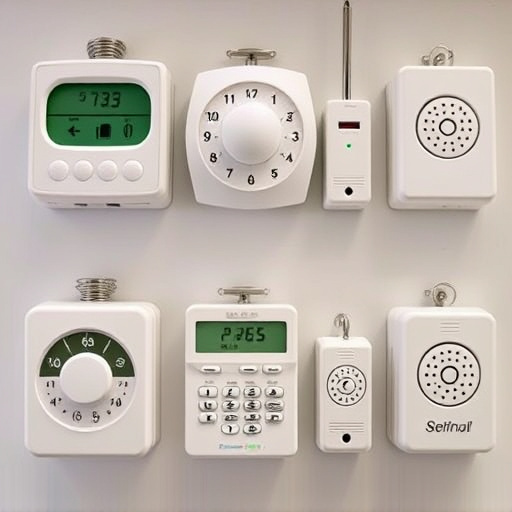Mobile panic button alarm systems with a Personal Alarm Range in Buildings offer discrete emergency help within structures, transmitting signals via mobile networks or Wi-Fi to monitoring centers. These solutions enhance safety, mobility, and discretion, especially in diverse environments like residential and commercial spaces. Optimizing personal alarm ranges involves strategic sensor placement and smart home integration for residential settings, while commercial spaces require broader coverage, robust networks, and seamless security system integration. Case studies prove their effectiveness, demonstrating swift mobilization of response teams during emergencies and enhancing overall safety.
“Mobile panic button alarm systems are transforming personal safety, especially within buildings. This article delves into their multifaceted benefits and functionalities, shedding light on how these innovative solutions enhance security. We explore the critical role of personal alarm range in buildings, highlighting its impact on quick response times during emergencies.
Furthermore, we provide practical insights for implementing and integrating mobile alarm systems across diverse environments, including case studies showcasing successful deployments.”
- Understanding Mobile Panic Button Alarm Systems: Their Functionality and Benefits
- The Role of Personal Alarm Range in Buildings: Ensuring Safety and Quick Response
- Implementing and Integrating Mobile Alarm Systems: Considerations for Different Environments
- Case Studies: Success Stories of Mobile Panic Button Alarm Systems in Action
Understanding Mobile Panic Button Alarm Systems: Their Functionality and Benefits
Mobile panic button alarm systems are designed to provide individuals with a swift and discrete means of seeking help in emergencies, especially while indoors. These innovative solutions offer a personal alarm range within buildings, allowing users to trigger an alert that can notify authorities or designated contacts promptly. The functionality is straightforward; a simple press of the panic button sends out a signal, often via mobile networks or Wi-Fi, to a monitoring center or pre-selected emergency contacts.
The benefits are numerous. Firstly, they offer peace of mind, knowing that help can arrive swiftly in case of distress. This is especially valuable in large buildings or spaces where individuals might be isolated. Secondly, mobility and discretion are key advantages; users can carry the device with them, ensuring accessibility anywhere in the building. Unlike traditional alarm systems, these mobile panic buttons do not require visible placement, making them ideal for personal safety without drawing attention to one’s location.
The Role of Personal Alarm Range in Buildings: Ensuring Safety and Quick Response
Implementing and Integrating Mobile Alarm Systems: Considerations for Different Environments
Implementing and integrating mobile panic button alarm systems requires careful consideration, especially when tailoring solutions for diverse environments. In residential settings, personal alarm ranges in buildings should be optimized to ensure immediate response during emergencies. This often involves strategic placement of sensors and alarms, taking into account floor plans and common areas like hallways and stairwells. For instance, smart home integration can enhance functionality, allowing users to trigger alerts remotely or through automated systems.
In contrast, commercial spaces like offices or public venues present unique challenges. Here, the focus shifts to broader coverage and more robust communication networks. Integrating mobile alarms with existing security systems, access control, and surveillance technology becomes crucial. Considerations include battery life, signal strength in large or multi-story buildings, and ensuring seamless connectivity for real-time emergency notifications. Regular testing and maintenance are essential to guarantee system reliability in these dynamic environments.
Case Studies: Success Stories of Mobile Panic Button Alarm Systems in Action
In various settings, from schools and colleges to corporate offices and residential buildings, mobile panic button alarm systems have proven their worth through compelling case studies. These success stories highlight how swiftly these alarms can mobilise response teams during emergencies, significantly enhancing safety. For instance, in a recent implementation at a large university campus, students found the Personal Alarm Range in Buildings highly effective during a simulated active shooter scenario. The system allowed for immediate notification of authorities and emergency services, facilitating a coordinated and swift response.
Another notable case involves a high-rise apartment complex where the mobile panic button alarm system played a pivotal role in ensuring resident safety. During an attempted break-in, a resident activated the alarm from their smartphone, immediately dispatching security personnel and alerting nearby police units. This rapid response not only deterred the intruder but also prevented potential harm to the resident. These real-world applications underscore the capability of mobile panic button alarm systems to transform spaces into safer environments through their robust functionality and user-friendly design.
Mobile panic button alarm systems are transforming personal safety, especially within buildings. By leveraging technology, these systems offer swift response times and enhanced security, ensuring that individuals feel protected and supported. The integration of mobile alarms considers diverse environments, making them adaptable to various settings. Case studies demonstrate their effectiveness in real-world scenarios, highlighting the significant role they play in fostering safe spaces. When it comes to personal alarm range in buildings, these systems provide a vital tool for quick interventions, proving indispensable in today’s safety landscape.
